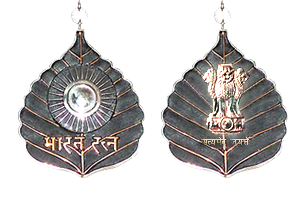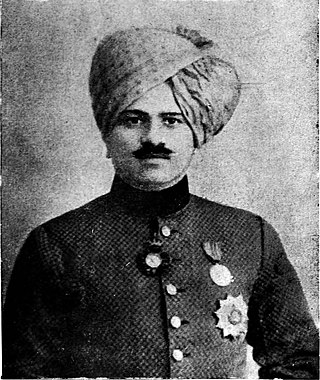Related Research Articles

The Padma Vibhushan is the second-highest civilian award of the Republic of India, after the Bharat Ratna. Instituted on 2 January 1954, the award is given for "exceptional and distinguished service". All persons without distinction of race, occupation, position or sex are eligible for these awards. However, government servants including those working with PSUs, except doctors and scientists, are not eligible for these Awards. As of 2022, the award has been bestowed on 325 individuals, including nineteen posthumous and twenty-one non-citizen recipients.
The Padma Bhushan is the third-highest civilian award in the Republic of India, preceded by the Bharat Ratna and the Padma Vibhushan and followed by the Padma Shri. Instituted on 2 January 1954, the award is given for "distinguished service of a high order...without distinction of race, occupation, position or sex." The award criteria include "service in any field including service rendered by Government servants" including doctors and scientists, but exclude those working with the public sector undertakings. As of 2020, the award has been bestowed on 1270 individuals, including twenty-four posthumous and ninety-seven non-citizen recipients.

Pullela Gopichand is a former Indian badminton player. Currently, he is the Chief National Coach for the India national badminton team. He won the All England Open Badminton Championships in 2001, becoming the second Indian to achieve this feat after Prakash Padukone. He runs the Gopichand Badminton Academy. He received the Arjuna Award in 1999, the Dronacharya Award in 2009 and the Padma Bhushan – India's third highest civilian award – in 2014.

Republic Day is the day when India marks and celebrates the date on which the Constitution of India came into effect on 26 January 1950. This replaced the Government of India Act 1935 as the governing document of India, thus turning the nation into a republic separate from British Raj. The constitution was adopted by the Indian Constituent Assembly on 26 November 1949 and came into effect on 26 January 1950. 26 January was chosen as the date for Republic Day as it was on that day in 1930 when the Declaration of Indian Independence was proclaimed by the Indian National Congress.
Ramanlal C. Mehta was an Indian musician and musicologist. In 2009, he was awarded the Padma Bhushan, India's third-highest civilian honour.

Abhinav Apjit Bindra is an Indian Olympic gold medallist, retired sport shooter, and businessman. He is the first and one of only 2 Indians to win an Individual Olympic Gold Medal. He is the first Indian to have held concurrently the world and Olympic titles for the men's 10-meter air rifle event, having earned those honors at the 2008 Summer Olympics and the 2006 ISSF World Shooting Championships. Bindra has also won seven medals at the Commonwealth Games and three medals at the Asian Games.

The Indian honours system is the system of awards given to individuals for a variety of services to the Republic of India. The categories of awards are as follows:
Raj Ratna was a title of high honour, a civilian award, which was prevalent in the princely states of India during the British Raj.

The Surat Agency was one of the agencies of British India in the Bombay Presidency.
Gyan Prakash Chopra (1920-2011) was an Indian educationist, credited with the establishment of several educational institutions in India. A recipient of the Padma Shri in 1999, he was honored again by the Government of India, in 2010, with the Padma Bhushan, the third highest civilian award, for his services to the field of education.

Shrimant Raja Sir Chintamanrao Dhundirao Patwardhan K.C.S.I, K.C.I.E was the 3rd Raja of the princely state of Sangli of British Raj during the reign. He signed the accession to the Indian Union on 19 February 1948 which ended the separate existence of Sangli State.
References
- 1 2 3 Rattanji Daboo, Dinshaw, Raj Ratna, BA, Zamindar; b. 25 September 1835; Representative, Baroda Government at the ... Central Communication Board; Awarded 'Raj Bhusan' and a silver medal 1927; title of 'Raj Ratna* with a gold medal.. All India co-operative review, Volume 8
- ↑ McClenaghan, Tony (1996). Indian Princely Medals: A Record of the Orders, Decorations, and Medals of the Indian Princely States. Lancer Publishers. p. 155. ISBN 9781897829196 . Retrieved 23 August 2017.
- 1 2 Indian & Pakistan Year Book & Who's who. Bennett, Coleman & Company. 1950. p. 728. Retrieved 22 August 2017.
- ↑ The Indian Year Book. Bennett, Coleman & Company. 1942. p. 1064. Retrieved 22 August 2017.